Evaluation of a Configurable, Mobile and Modular Floor-Pen System for Group-Housing of Laboratory Rabbits
Abstract
Simple Summary
Abstract
1. Introduction
2. Materials and Methods
2.1. Animals
2.2. Laboratory Environment
2.3. Housing
2.3.1. Single mobile-R-pen
2.3.2. Small mobile-R-pens
2.3.3. Large mobile-R-pens
2.4. Procedure
2.4.1. Health Study
2.4.2. Behavioral Study
2.5. Statistical analysis
3. Results
4. Discussion
5. Conclusions
Author Contributions
Funding
Institutional Review Board Statement
Data Availability Statement
Acknowledgments
Conflicts of Interest
References
- European Union. Directive 2010/63/EU of the european parliament and of the council on the protection of animals used for scientific purposes. Off. J. Eur. Union 2010, 276, 33–79. [Google Scholar]
- Held, S.D.; Turner, R.J.; Wootton, R.J. Choices of laboratory rabbits for individual or group-housing. Appl. Anim. Behav. Sci. 1995, 46, 81–91. [Google Scholar] [CrossRef]
- Turner, R.J.; Held, S.D.; Hirst, J.E.; Billinghurst, G.; Wootton, R.J. An immunological assessment of group-housed rabbits. Lab. Anim. 1997, 31, 362–372. [Google Scholar] [CrossRef]
- DiVincenti, L., Jr.; Rehrig, A.N. The Social Nature of European Rabbits (Oryctolagus cuniculus). J. Am. Assoc. Lab. Anim. Sci. 2016, 55, 729–736. [Google Scholar] [PubMed]
- Fuentes, G.C.; Newgren, J. Physiology and clinical pathology of laboratory new zealand white rabbits housed individually and in groups. J. Am. Assoc. Lab. Anim. Sci. 2008, 47, 35–38. [Google Scholar] [PubMed]
- Poggiagliolmi, S.; Crowell-Davis, S.; Alworth, L.; Harvey, B. Environmental enrichment of New Zealand White rabbits living in laboratory cages. J. Vet. Behav. Clin. Appl. Res. 2011, 6, 343–350. [Google Scholar] [CrossRef]
- DiVincenti, L., Jr.; Rehrig, A.N. Social Behavior of Adult Male New Zealand White Rabbits Housed in Groups or Pairs in the Laboratory. J. Appl. Anim. Welf. Sci. 2017, 20, 86–94. [Google Scholar] [CrossRef]
- Love, J.A. Group housing: Meeting the physical and social needs of the laboratory rabbit. Lab. Anim. Sci. 1994, 44, 5–11. [Google Scholar] [PubMed]
- Council of Europe. Appendix A of the European Convention for the Protection of Vertebrate Animals Used for Experimental and Other Scientific Purposes [ETS 123]; Council of Europe Press: Straßbourg, France, 2006; pp. 1–108. [Google Scholar]
- Chu, L.R.; Garner, J.; Mench, J. A behavioral comparison of New Zealand White rabbits ( Oryctolagus cuniculus) housed individually or in pairs in conventional laboratory cages. Appl. Anim. Behav. Sci. 2004, 85, 121–139. [Google Scholar] [CrossRef]
- Nevalainen, T.O.; Nevalainen, J.I.; Guhad, F.A.; Lang, C.M. Pair housing of rabbits reduces variances in growth rates and serum alkaline phosphatase levels. Lab. Anim. 2007, 41, 432–440. [Google Scholar] [CrossRef]
- Huls, W.L.; Brooks, D.L.; Bean-Knudsen, D. Response of adult New Zealand white rabbits to enrichment objects and paired housing. Lab. Anim. Sci. 1991, 41, 609–612. [Google Scholar]
- Aguilar-Roblero, R.; Gonzalez-Mariscal, G. Behavioral, neuroendocrine and physiological indicators of the circadian biology of male and female rabbits. Eur. J. Neurosci. 2020, 51, 429–453. [Google Scholar] [CrossRef] [PubMed]
- Mahler, C.M.; Berard, M.; Feinstein, R.; Gallagher, A.; Illgen-Wilcke, B.; Pritchett-Corning, K.; Raspa, M. FELASA recommendations for the health monitoring of mouse, rat, hamster, guinea pig and rabbit colonies in breeding and experimental units. Lab. Anim. 2014, 48, 178–192. [Google Scholar]
- Coda, K.A.; Fortman, J.D.; Garcia, K.D. Behavioral Effects of Cage Size and Environmental Enrichment in New Zealand White Rabbits. J. Am. Assoc. Lab. Anim. Sci. 2020, 59, 356–364. [Google Scholar]
- Dixon, L.; Hardiman, J.; Cooper, J. The effects of spatial restriction on the behavior of rabbits (Oryctolagus cuniculus). J. Vet. Behav. Clin. Appl. Res. 2010, 5, 302–308. [Google Scholar] [CrossRef]
- Valuska, A.; Mench, J. Size does matter: The effect of enclosure size on aggression and affiliation between female New Zealand White rabbits during mixing. Appl. Anim. Behav. Sci. 2013, 149, 72–76. [Google Scholar] [CrossRef]
- Graf, S.; Bigler, L.; Failing, K.; Würbel, H.; Buchwalder, T. Regrouping rabbit does in a familiar or novel pen: Effects on agonistic behaviour, injuries and core body temperature. Appl. Anim. Behav. Sci. 2011, 135, 121–127. [Google Scholar] [CrossRef]
- Braconnier, M.; Gómez, Y.; Gebhardt-Henrich, S. Different regrouping schedules in semi group-housed rabbit does: Effects on agonistic behaviour, stress and lesions. Appl. Anim. Behav. Sci. 2020, 228, 105024. [Google Scholar] [CrossRef]
- Díez Valle, C.; García-Abad, C.S.; Pérez Garrido, J.G.; Bartolomé, D.J.; Eguren, V.G.; Wheatley, C.; Alonso de la Varga, M.E.; Gaudioso Lacasa, V.R. Behavioural activity of wild rabbits (Oryctolagus cuniculus) under semi-natural rearing systems: Establishing a seasonal pattern. World Rabbit Sci. 2013, 21, 263–270. [Google Scholar] [CrossRef]
- Baumans, V. Environmental enrichment for laboratory rodents and rabbits: Requirements of rodents, rabbits, and research. ILAR J. 2005, 46, 162–170. [Google Scholar] [CrossRef]
- Whary, M.; Peper, R.; Borkowski, G.; Lawrence, W.; Ferguson, F. The effects of group housing on the research use of the laboratory rabbit. Lab. Anim. 1993, 27, 330–341. [Google Scholar] [CrossRef] [PubMed]
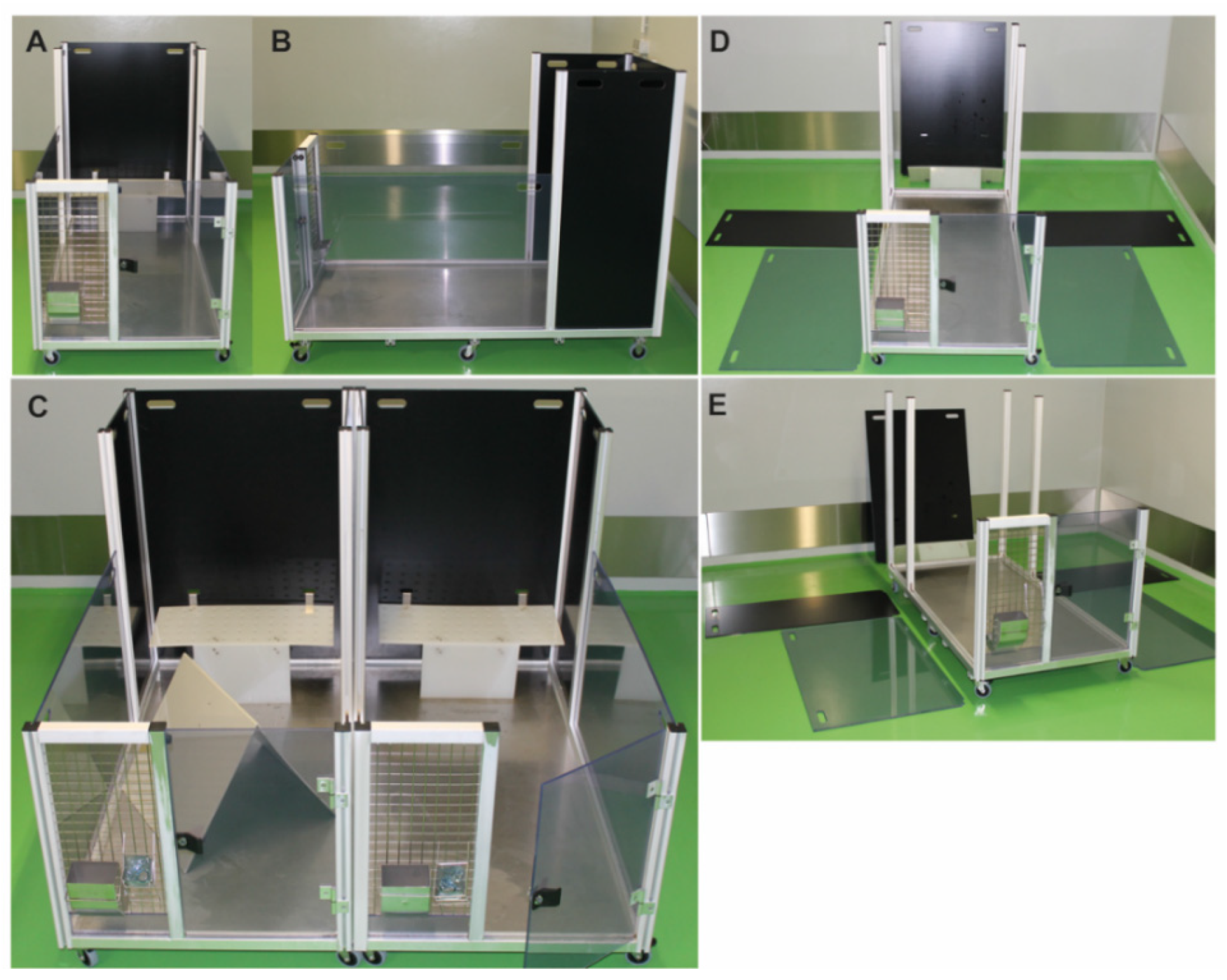
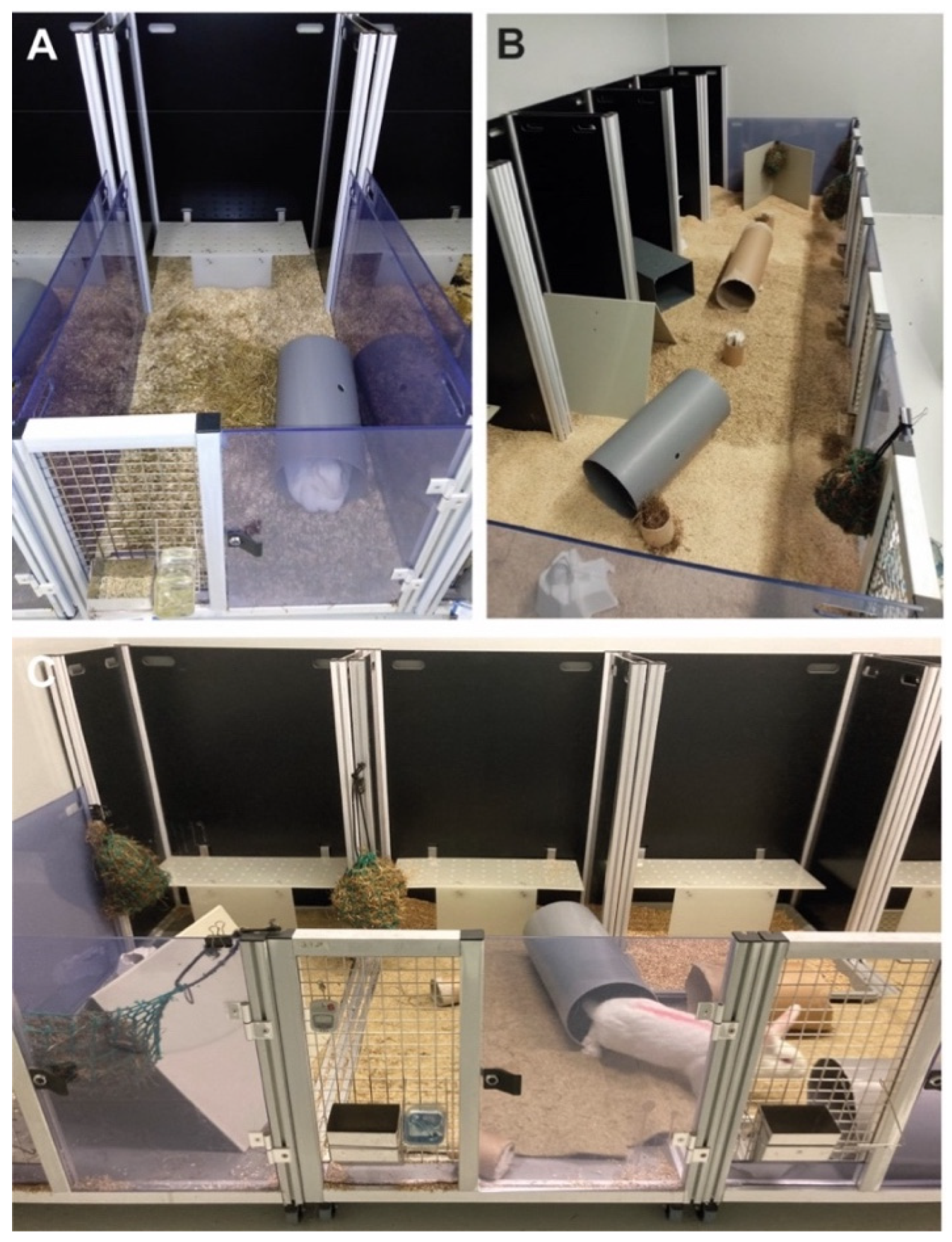
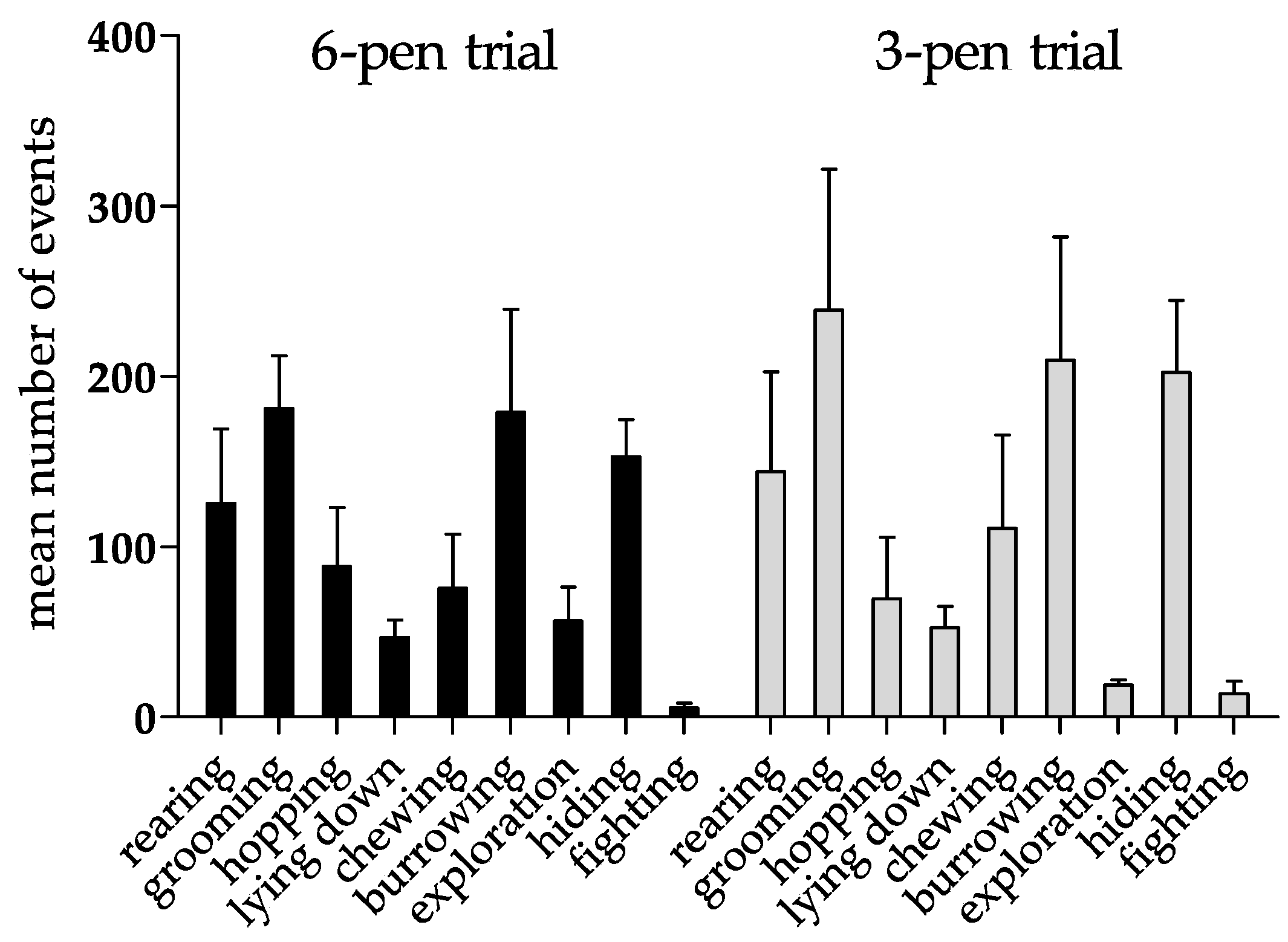
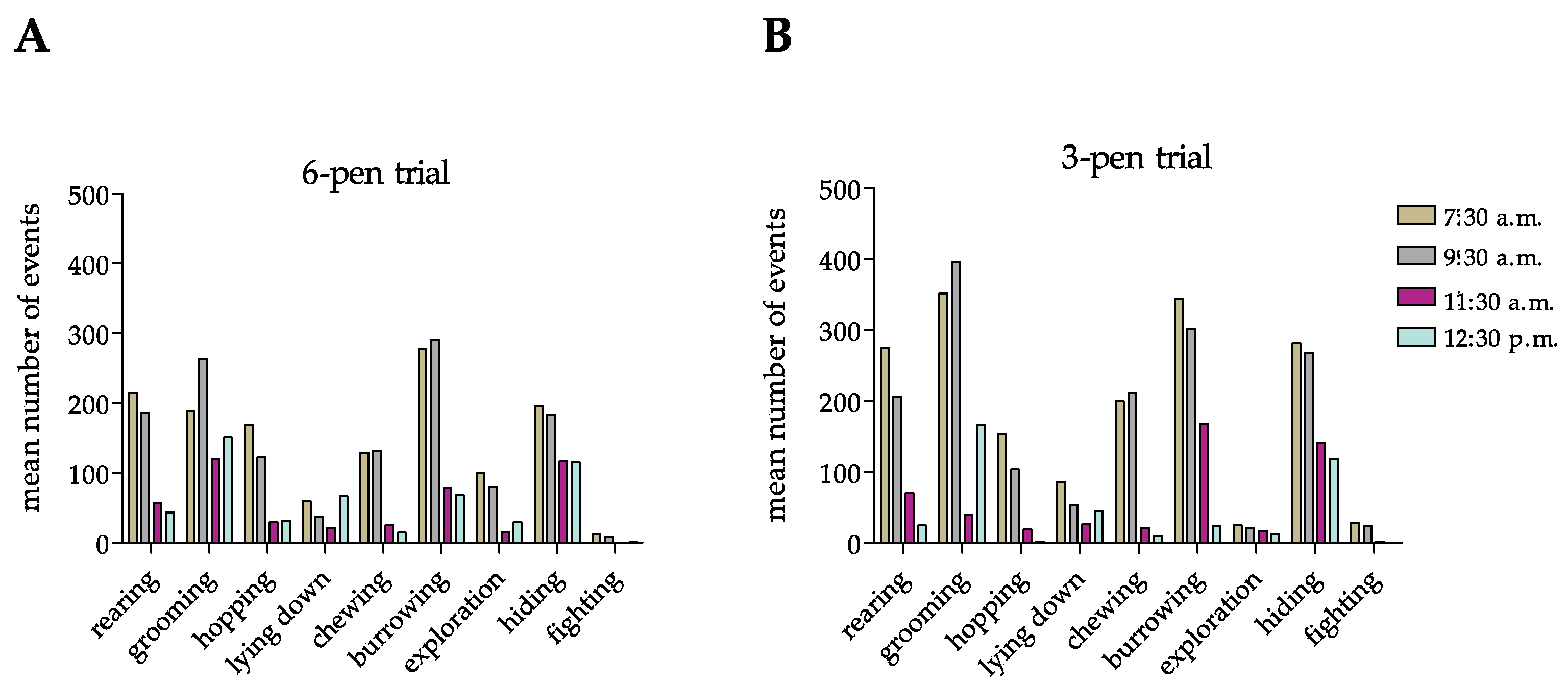
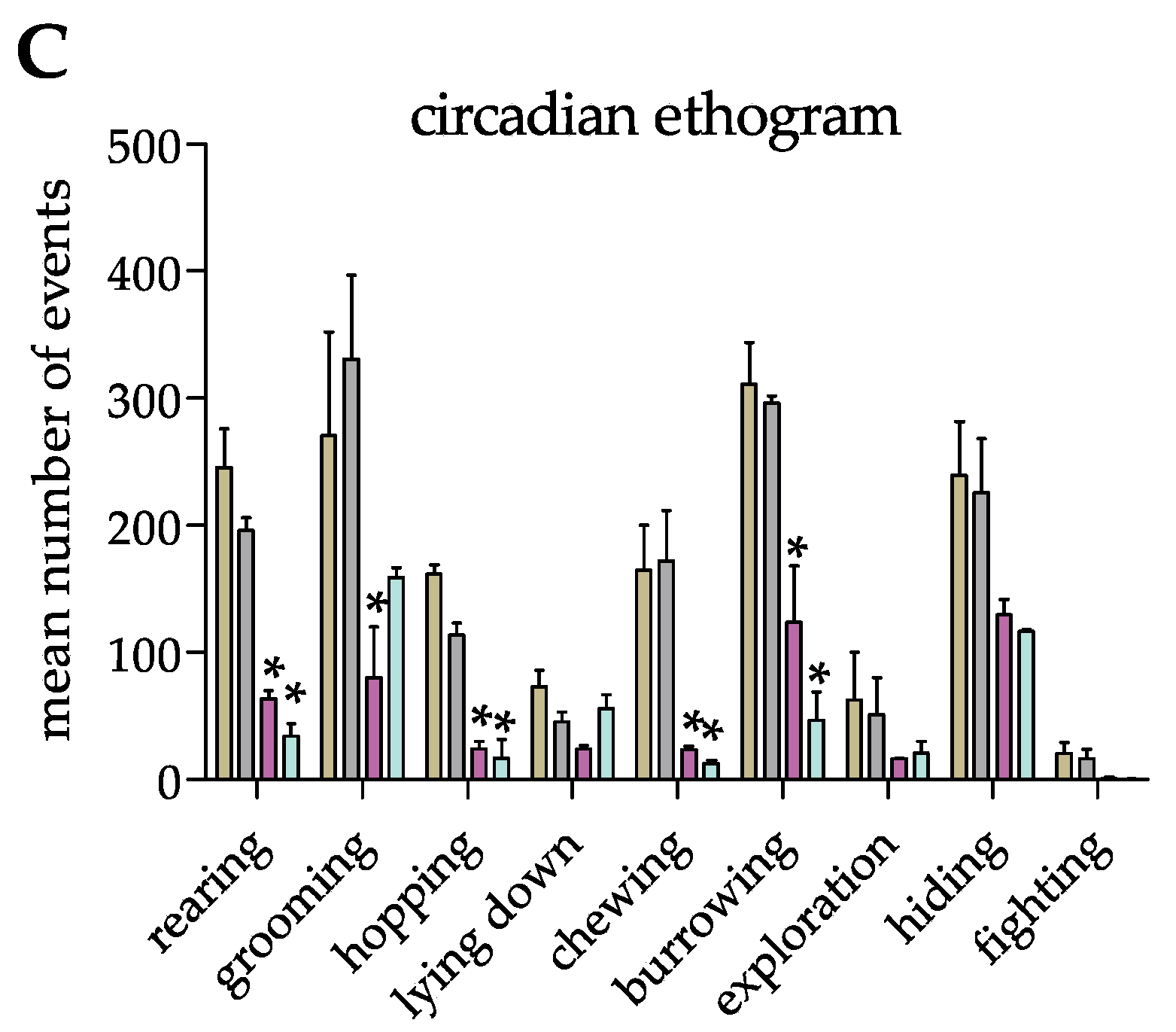
| Rabbit Behavior Definition | |
|---|---|
| Rearing | Animal is up on both hind legs and torso is perpendicular to the floor |
| Grooming | Animal is licking or scratching its coat or face |
| Hopping | Animal is moving forward by pushing hindlimbs followed by forelimbs |
| Lying down | Animal is in a horizontal position on an elevated platform |
| Chewing | Animal is actively biting on non-food material |
| Burrowing | Animal is using forepaws to dig into the bedding material and to scratch on the floor of the pen |
| Eating | Animal is biting and swallowing food |
| Drinking | Animal is consuming water |
| Exploration | Animal is actively moving around, jumping, and sniffing on enrichment material |
| Hiding | Animal is sitting/lying under or behind tent/tube/platform or opaque wall element |
| Fighting | Animal is biting, chasing, mounting, or snapping at other rabbits |
| Other | Animal performs other behavioral patterns than those stated above. The value is calculated as the difference of all measured behaviors from the overall time of observation |
| Rabbit Behavior | Baseline (a) | 6-Pen Trial (b) | 3-Pen Trial (c) | p-Value | |||
|---|---|---|---|---|---|---|---|
| Median | IQR | Median | IQR | Median | IQR | K–W Test | |
| Rearing | 7.5 | 29.25 | 7.5 | 13.5 | 15.0 | 18.0 | n.s. |
| Grooming | 36.0 | 47.25 | 15.0 | 46.5 | 36.0 | 69.0 | n.s. |
| Hopping | 13.5 | 11.25 | 12.0 | 21.0 | 6.0 | 7.5 | n.s. |
| Lying down | 30.0 | 0.0 | 84.5 | 481.5 | 279.0 | 204.0 | n.s. |
| Chewing | 12.0 | 6.0 | 16.5 | 3.0 | 49.5 | 94.5 | n.s. |
| Burrowing | 7.5 | 38.5 | 42.0 | 42.0 | 19.5 | 48.0 | n.s. |
| Eating | 355.5 | 756.8 | 567.0 | 804.0 | 594.0 | 609.0 | n.s. |
| Drinking | 426.0 | 648.0 | 246.0 | 294.8 | 91.5 | 354.7 | n.s. |
| Exploration | 45.0 | 82.5 | 96.0 | 127.5 | 39.0 | 58.5 | n.s. |
| Hiding | 859.5 | 1523.2 (a,c) | 510.0 | 801.0 (b,c) | 261.0 | 474.7 | 0.0432 |
| Fighting | 0.0 | 0.0 (a,c) | 28.5 | 71.25 (b,c) | 16.5 | 34.5 | 0.0001 |
| Other | 7.5 | 175 | 393 | ||||
Publisher’s Note: MDPI stays neutral with regard to jurisdictional claims in published maps and institutional affiliations. |
© 2021 by the authors. Licensee MDPI, Basel, Switzerland. This article is an open access article distributed under the terms and conditions of the Creative Commons Attribution (CC BY) license (https://creativecommons.org/licenses/by/4.0/).
Share and Cite
Matzek, D.; Baldauf, H.-M.; Schieweck, R.; Popper, B. Evaluation of a Configurable, Mobile and Modular Floor-Pen System for Group-Housing of Laboratory Rabbits. Animals 2021, 11, 977. https://doi.org/10.3390/ani11040977
Matzek D, Baldauf H-M, Schieweck R, Popper B. Evaluation of a Configurable, Mobile and Modular Floor-Pen System for Group-Housing of Laboratory Rabbits. Animals. 2021; 11(4):977. https://doi.org/10.3390/ani11040977
Chicago/Turabian StyleMatzek, Dana, Hanna-Mari Baldauf, Rico Schieweck, and Bastian Popper. 2021. "Evaluation of a Configurable, Mobile and Modular Floor-Pen System for Group-Housing of Laboratory Rabbits" Animals 11, no. 4: 977. https://doi.org/10.3390/ani11040977
APA StyleMatzek, D., Baldauf, H.-M., Schieweck, R., & Popper, B. (2021). Evaluation of a Configurable, Mobile and Modular Floor-Pen System for Group-Housing of Laboratory Rabbits. Animals, 11(4), 977. https://doi.org/10.3390/ani11040977






